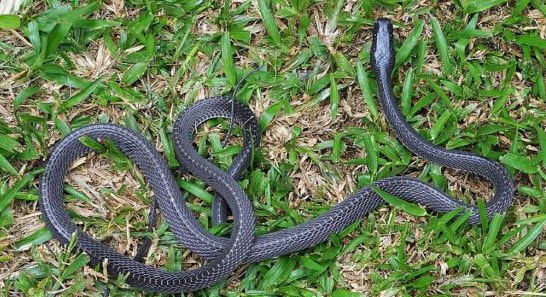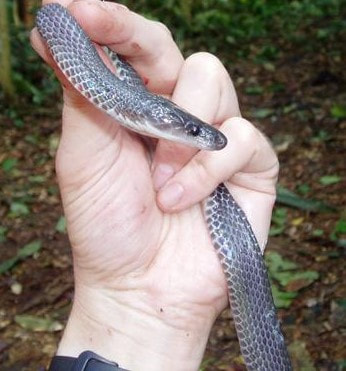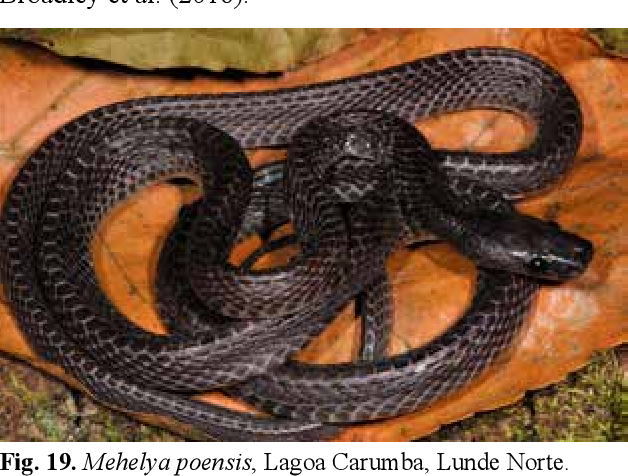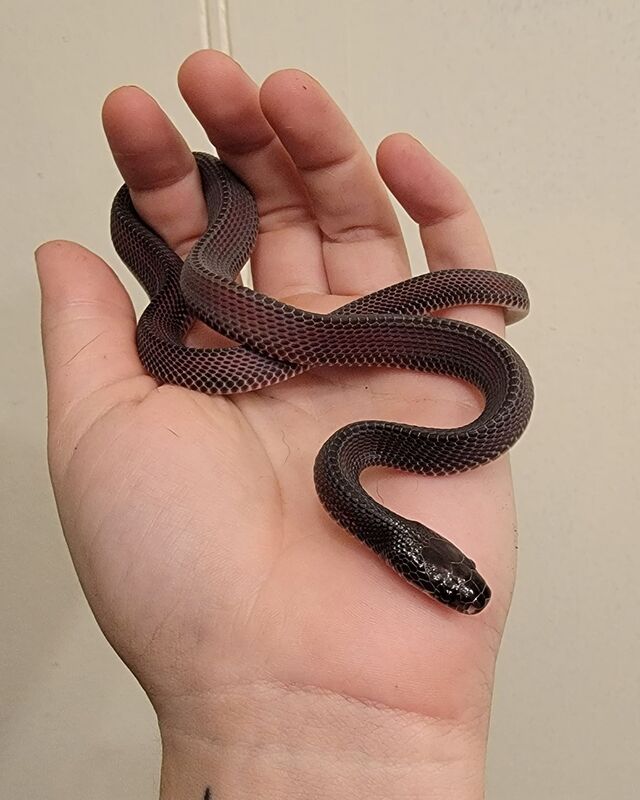First things first...
Before we get into it, its important to be sure we're on the same page. There are a few species of file snake, and they are not all the same. Many misconceptions about file snakes are built around misidentification, so first lets be sure we know which file snake we're discussing.
Limaformosa is the current genus (in the family lamprophiidae) that contains file snakes. They have also been listed in Gonionotophis. Previous to the their placement in Limaformosa, they were listed in Mehelya. This is why most online stores list all file snakes as "mehelya crossi". Problem is that not all file snakes are of the "crossi" species. There are 3 species of file snake that are common (enough) in captivity to be imported into the US. Crossi, Poensis, and Capensis.
Poensis-
|
The primary way to tell a poensis file snake from a crossi is that the poensis have a rectangular shaped head and slender bodies. They tend to be more grey than pink/purple although there certainly are some pink poensis too. They are primarily lizard and snake eaters, and there are several sightings of them up trees suggesting a more aboreal nature. They often come in heavily parasitized, and as far as I can tell, they are fairly delicate, even after being fully treated.
|
|
I have hatched a few poensis, from wild caught gravid females, but I do not find them easy to start. Even when using live geckos or anoles. I feel this may be a species we just don't understand well yet. Hopefully we will gain more understanding of them in the wild to give us more clues as to how to keep them in an optimal way in captivity. Until then, it may be a little while before we work out the kinks on this species.
Capensis
The subject of feeding reptile eating reptiles an exclusively rodent diet is a touchy one, and I certainly wont make friends for saying this, but in the name of education it must be mentioned.
Rodents are high in fat, and reptiles that naturally eat other reptiles aren't built for a high fat diet. They are prone to developing hepatic lipidosis, a condition that causes animals to prematurely die of liver failure. While it certainly doesn't happen overnight, the kind of diet that leads to hepatic lipidosis can halve an animals natural lifespan. This brings up ethical concerns about the practice. Yes, there are ways around this, but to be most ethical it would require careful monitoring of liver enzymes, and perhaps a diversity of diet to include other reptiles to "lean out" the diet. The "other reptiles" will need to come from a non-parasitized source as well, so the "cheap" wild caught animals commonly used wouldn't be practical in a "best practices" sense, due to the fact you would need to be constantly deworming feeders or breeding your own. This is why I don't personally keep this species, despite its beauty. I'm simply not prepared to offer these beautiful animals the kind of diet that would guarantee them the long natural life they deserve.
Rodents are high in fat, and reptiles that naturally eat other reptiles aren't built for a high fat diet. They are prone to developing hepatic lipidosis, a condition that causes animals to prematurely die of liver failure. While it certainly doesn't happen overnight, the kind of diet that leads to hepatic lipidosis can halve an animals natural lifespan. This brings up ethical concerns about the practice. Yes, there are ways around this, but to be most ethical it would require careful monitoring of liver enzymes, and perhaps a diversity of diet to include other reptiles to "lean out" the diet. The "other reptiles" will need to come from a non-parasitized source as well, so the "cheap" wild caught animals commonly used wouldn't be practical in a "best practices" sense, due to the fact you would need to be constantly deworming feeders or breeding your own. This is why I don't personally keep this species, despite its beauty. I'm simply not prepared to offer these beautiful animals the kind of diet that would guarantee them the long natural life they deserve.
Crossi
|
So that leaves us with Crossi, the species this caresheet addresses. Crossi have rounded heads and no line down the back. Im currently refining two lines one that is pink and one that's purple. I also have a possibly axanthic (black) line in the works.
TemperamentFile snakes are exceptionally docile snakes. On occasion they may squiggle a little, but at the time of this writing, I have never once been bit by one. I don't know anyone else who has either. I can not say this about ball pythons, boas, corn snakes, kingsnakes, or any of the other common pet snakes. With the right care, they make fantastic pets.
|
Size
As babies they are roughly 8-12" long and are housed in v15s (18"x 5"). Cage sizes progress as they grow. As adults they are about 4-5 feet. I keep my files in 32qts (24x18x7") or v70 tubs (34x18x6) depending on size. That's roughly 40-50 gallons in fish tank size.
Food
|
Crossi file snakes can be kept on appropriate sized mice their entire lives. Exceptionally large adult females may require an extra mouse or to be fed small rats to keep body weight up, but most will fall into that jumbo mouse range. Most file snakes are voracious, "junk drawer" type snakes that will feed on frozen thawed very easily, although some will require more convincing. I aim for a mouse that weighs roughly 15% of the animals body weight.
Cage Furnishings |
"here's a tip: |
I use prococo for bedding. I recommend you do too. Its texture allows them to borrow should they choose and it can handle more humidity. Do not use wood or dirt type substrates. The dust from the wood or dirt will get lodged into their nostrils causing health problems. You will need a large heavy water bowl, big enough for the file snake to soak in. I also use a humid hide made up of a tupperware container filled with spagnum moss with an access hole cut in the side. A dry hide is also provided. They don't climb much so branches etc aren't necessary, but you can add them if you like.
Temperature & Humidity
Temperature ranges from 75 degrees on the cold side to 88 degrees on the warm side in my enclosures.
Humidity ranges from roughly 50% everywhere to 80% inside the humid hide.
The point is to create microclimates, give them the opportunity to be wherever they want.
Humidity ranges from roughly 50% everywhere to 80% inside the humid hide.
The point is to create microclimates, give them the opportunity to be wherever they want.
Interesting facts
Files have a fairly unique skeletal system. They always are, and always should be, a triangle shape.
File snakes sometimes pop or scrape their own scales off. They almost always grow back. You can discourage this by providing a large water bowl they can soak in.
File snakes sometimes pop or scrape their own scales off. They almost always grow back. You can discourage this by providing a large water bowl they can soak in.
A word on parasites...
Captive born file snakes are a pleasure and easy to keep. However, you absolutely must deworm your wild caught file snakes. Wild caught file snakes sometimes catch lung flukes that are deadly to snakes and transmittable to humans. I have contracted lung flukes and it is not pleasant, and very unlikely to be tested for in the US. I only found this because I ran a fecal on myself, then presented that to my physician for treatment. I mention this because it can make you or your family members sick. I don't mean to alarm or discourage you, but this really highlights the importance of deworming.
Don't get me wrong, wild caught snakes have a place in the hobby, they offer strong genetic material to refresh bloodlines and provide diversity amongst other things. I keep several of them myself. I'm not knocking the practice, but if you purchase wild caught snakes you absolutely must take responsibility for their health and acclimation which includes the deworming process.
Sadly there are many wild caught file snakes being sold as "captive born". So how do I know if my snake is wild caught?
You cant know for sure but here's some tips: If it's "too good to be true" price wise, its likely wild caught. Captive breeding is more expensive than reselling wild caught stock so if you paid less than $100 for it, then its very likely wild caught. If you bought it at a reptile trade show from a vendor that had a wide variety of other species from the same region, odds are it is wild caught. If you found ticks on it or others offered for sale by the same "breeder", it was definitely wild caught. If they don't know or cant tell you the scientific name of the species, they likely don't breed it, so its likely wild caught. Wild caught file snakes may behave different. They may look or seem uncomfortable for no reason (pacing, scared), not eat or eat voraciously but still fail to gain weight long term. They sometimes vomit food for seemingly no reason. They sometimes rally for a few months and then die inexplicably. If kept long term but not dewormed they often have reproductive issues.
To be honest, there are only a handful of file snake breeders i'm aware of in the US at the time of writing, so its best to assume any file snake you have acquired (without thoroughly researching its breeder) is going to be wild caught. Unfortunately, even being captive born doesn't guarantee that they will be parasite free as they can be kept in collections with other wild caught snakes that could have infected them. Buying a hatchling from an unknown source is also no guarantee, as they often are hatched in captivity from stressed out imported wild caught mothers, then regularly fail to thrive "inexplicably". The best thing to do with any snake you aren't certain of its origin is to have it dewormed. It's typically done with panacur, flagyl, or both. Fluke treatment will need praziquantel which has low safety margins so definitely do not attempt to treat file snakes yourself outside of veterinary supervision. Fortunately, with the aide of your local veterinarian, deworming is not difficult or expensive.
You can of course avoid the deworming process by purchasing your snake from a reputable breeder. There are a handful of them, and the cost to buy captive born is typically still less than the cost of purchasing wild caught then deworming, with better outcomes. If you have questions on the repute of a breeder there are several facebook groups where you can ask for others experiences too, so there's no need to guess.
I hope this page was helpful to you in your research on the captive care of file snakes. Thank you for reading it! Should you decide you'd like to add a new snake to your household please feel free to browse the available page, or contact me should you have more questions :)
Don't get me wrong, wild caught snakes have a place in the hobby, they offer strong genetic material to refresh bloodlines and provide diversity amongst other things. I keep several of them myself. I'm not knocking the practice, but if you purchase wild caught snakes you absolutely must take responsibility for their health and acclimation which includes the deworming process.
Sadly there are many wild caught file snakes being sold as "captive born". So how do I know if my snake is wild caught?
You cant know for sure but here's some tips: If it's "too good to be true" price wise, its likely wild caught. Captive breeding is more expensive than reselling wild caught stock so if you paid less than $100 for it, then its very likely wild caught. If you bought it at a reptile trade show from a vendor that had a wide variety of other species from the same region, odds are it is wild caught. If you found ticks on it or others offered for sale by the same "breeder", it was definitely wild caught. If they don't know or cant tell you the scientific name of the species, they likely don't breed it, so its likely wild caught. Wild caught file snakes may behave different. They may look or seem uncomfortable for no reason (pacing, scared), not eat or eat voraciously but still fail to gain weight long term. They sometimes vomit food for seemingly no reason. They sometimes rally for a few months and then die inexplicably. If kept long term but not dewormed they often have reproductive issues.
To be honest, there are only a handful of file snake breeders i'm aware of in the US at the time of writing, so its best to assume any file snake you have acquired (without thoroughly researching its breeder) is going to be wild caught. Unfortunately, even being captive born doesn't guarantee that they will be parasite free as they can be kept in collections with other wild caught snakes that could have infected them. Buying a hatchling from an unknown source is also no guarantee, as they often are hatched in captivity from stressed out imported wild caught mothers, then regularly fail to thrive "inexplicably". The best thing to do with any snake you aren't certain of its origin is to have it dewormed. It's typically done with panacur, flagyl, or both. Fluke treatment will need praziquantel which has low safety margins so definitely do not attempt to treat file snakes yourself outside of veterinary supervision. Fortunately, with the aide of your local veterinarian, deworming is not difficult or expensive.
You can of course avoid the deworming process by purchasing your snake from a reputable breeder. There are a handful of them, and the cost to buy captive born is typically still less than the cost of purchasing wild caught then deworming, with better outcomes. If you have questions on the repute of a breeder there are several facebook groups where you can ask for others experiences too, so there's no need to guess.
I hope this page was helpful to you in your research on the captive care of file snakes. Thank you for reading it! Should you decide you'd like to add a new snake to your household please feel free to browse the available page, or contact me should you have more questions :)












